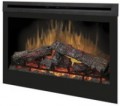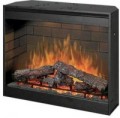Heating power
It is the heat output of the fireplace. With several intensity settings, the customer can choose the best option for each specific situation. For example, when returning to the house after a long absence, when the room has cooled down, the fireplace can be turned on at full power; if you just need to help the main heating system a little, it is better to use half the intensity so as not to overheat the air and not waste electricity; and so on.
Simulation mode power
The amount of energy consumed by the electric fireplace when operating in flame simulation mode (see "Operating modes"). Since in this mode, it is not necessary to spend energy on heating, the power consumption in it is noticeably lower. Its specific value significantly depends on the principle of flame simulation (see below).
Functions
-
Temperature adjustment. This function allows you to optimally adjust the operation of the device to the necessary conditions by setting a specific value for the desired heating temperature. The vast majority of these models of heaters are equipped with electronic programmers with a display, less often with mechanical devices for accurately setting the temperature.
-
Thermostat. A device for selecting the intensity of heating and maintaining the specified temperature limits in the served room with some slight fluctuations. Heaters with a thermostat automatically turn off when the set temperature level is reached and turn on again when it gets colder by a couple of degrees. Models of this order usually do not provide for the possibility of choosing a specific temperature, and thermostats in them are presented in the form of simple mechanical regulators of the heating intensity.
-
Fan heater. The presence in the design of the fireplace of a special fan that supplies hot air from the device. Due to this, the room warms up faster than with natural convection (without a fan).
-
Flame brightness adjustment. The ability to change the brightness of the flame visible in the "furnace" of the fireplace. This function allows you to customize the appearance of the device according to the mood and situation: for example
..., in soft evening lighting, you can “mute” the fireplace so that it does not blind your eyes, and in bright light (for example, on a clear day) — you can make the flame brighter and more noticeable .
— Flame intensity adjustment . The ability to change the intensity of the flame imitated by the fireplace — so that it looks calm or stormy.
- Flame colour adjustment. Another setting for the decor of the room. It allows you to change the colour of the flame, which allows you to set both a cold blue fire and a hot red one. However, other combinations of colour shades of the flame can be used in fireplaces. The colour palette of fire imitation depends on the specific model of the fireplace. Some models allow you to use the automatic change of the flame palette, which is characteristic of the natural combustion cycle, from lighting a fire to smouldering coals. In advanced-class fireplaces, in addition to adjusting the colour palette of the flame, the ability to adjust the intensity and brightness of combustion is added.
— Air purification filter. The presence of a filter in the design of the fireplace, which cleans the air from various impurities. True, the efficiency of such cleaning is usually not as high as when using special equipment; on the other hand, intensive filtration is not required in residential areas. The filter can be designed both to remove small particles (smoke, dust) and to fight odours.
— Air humidification. The ability of the fireplace to humidify the air. The most comfortable relative humidity for a person is considered to be about 60-70%. However, during the cold season, the humidity in residential premises may drop. Humidifiers are used to restore optimal conditions.
- Shutdown timer. This timer provides automatic shutdown of the electric fireplace after the time set by the user. Thanks to this, you can, for example, turn on the device in flame simulation mode instead of a night light, set a timer and go to bed without worrying about having to turn off the fireplace manually.
— Open window sensor. A special sensor allows the device to automatically recognize when a window/vent is opened for ventilation. In the process of ventilating the room, the fireplace either turns off completely or goes into the most economical operation mode. This function allows you to save energy, because during the ventilation process, room heat will still evaporate to the street. The very fact of ventilation is most often recorded by the programmer. For this, automation can use either traditional magnetic contact sensors or draft sensors (inflow of cold air).
